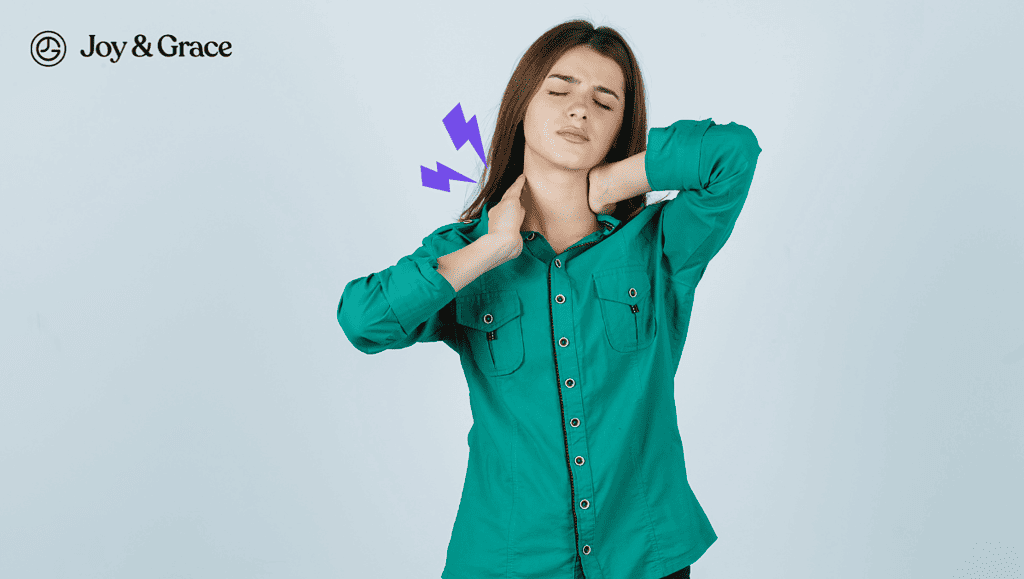Millions worldwide suffer from mechanical neck pain. This number will continue to rise as the world continues to modernize. But what is mechanical neck pain? The Joy & Grace Team has looked through many scientific journals and clinical studies to find out what it is, what causes it, and what you can do to get rid of it.
Let’s dive in!
What Is Mechanical Neck Pain?
Our neck is an interrelation of bones, muscles, ligaments, joints, and nerves. Any damage to these tissues results in a type of neck pain called mechanical neck pain. Due to its confinement to the neck, it is also known as cervical or axial pain.
Compared to other forms of neck pain, mechanical neck pain is not caused by or related to any disease. This form of neck pain is due to injury to neck tissue, and has no signs of inflammation, infection or malignancy.
Why Is Mechanical Neck Pain Disorder Also Referred To As Non-Specific Neck Pain?

Since mechanical neck pain is not related to a disease, it is also known as non-specific neck pain. This means the pain is due to wear and tear or injury to the tissues of the neck.
Another term associated with mechanical neck pain is cervical spondylosis. Cervical spondylosis refers to mechanical neck pain with degenerative changes. Researchers consider cervical spondylosis a part of aging, as it starts to appear in people over 30.
What Is The Global Prevalence Of Mechanical Neck Pain Disorder?
Mechanical neck pain is common. Over 67% of the world’s population experience mechanical neck pain. With some of the harmful habits that come with modern living, this number may continue to rise. Mechanical neck pain should be a public health concern and is a leading cause of why people worldwide miss work. Relatable much?
What Are The Causes Of Mechanical Neck Pain?

A variety of factors can cause mechanical neck pain. Studies point to genetics as a major factor in neck pain. So if neck pain runs in your family, it may explain your neck pain, especially if combined with any of the following factors:
- Injury
Maybe you got into a minor car accident or went to a concert and vibed too hard. Whatever the reason, rapid back-and-forth neck movement can result in whiplash injury.
This type of injury can cause tiny tears in our neck muscles, causing muscle spasms and pain. Whiplash can also destabilize the cervical vertebra, causing wear and tear. The damage to the cervical discs irritates the surrounding nerves, generating pain.
So whenever you are on the road or at a rock concert, remember to drive safely and tone down the headbanging.
- Poor Posture
Poor posture is one of the leading causes of mechanical neck pain, and we’re all guilty of it. Poor posture is part of our daily lives, from slouching at work to scrolling through our phones all day.
The most common posture that results in neck pain is the forward head posture. This is also known as the texting neck or iHunch. This position causes the muscles to tighten and weaken over time, resulting in pain.
- Sedentary Lifestyle
A lack of physical activity can also lead to neck pain due to decreased muscle function. Furthermore, a sedentary lifestyle increases the risk of obesity. The increased body weight puts more tension on the neck, resulting in cervical strain.
- Stress
Stress can be due to work, family life, or even just getting up in the morning (yes, it can be tough for us, too!). We may not realize it, but daily life stress may contribute to our neck pain.
According to a study, stress causes the muscles that support our neck to tense up. The cervical spine becomes strained as muscle tension persists, leading to neck pain. Stress is a significant cause of chronic neck pain in office workers.
Other psychosocial causes linked to mechanical neck pain include depression and anxiety.
What Are The Symptoms Of Mechanical Neck Pain?

In mechanical neck pain, the pain can either occur on one or both sides of the neck. The pain often starts as a dull ache but becomes sharper upon neck movement. It may be acute, disappearing as fast as it came, or chronic. If the pain is chronic, it may come and go or be constant, persisting for months or years. In cases where the pain is so severe, you may have decreased range of motion.
The mechanisms that cause mechanical neck pain can also bring other symptoms. A common accompanying symptom is a cervicogenic headache. This is because the nerves that supply our neck also travel into the head.
Cervicogenic headache is a type of headache that occurs after neck movement. The pain often affects only one side of the head but can spread down to the face.
The mechanism of cervical strain can also cause a pinched nerve. This presents as pain in the shoulder or forearm. You may also experience tingling, numbness, or weakness in your limbs.
Other symptoms include muscle spasms, blurry vision, dizziness, and lack of balance.
What Is The Difference Between Inflammatory And Mechanical Neck Pain?
Inflammatory diseases, such as rheumatoid arthritis, can also cause neck pain. People with inflammatory neck pain often have other signs of inflammation. They may experience fever, fatigue, or swelling.
Many diseases, such as cancer, can masquerade as mechanical neck pain. If you are experiencing neck pain, it is okay to talk to your doctor about it. The correct diagnosis can help prevent serious complications and allow for treatment.
What Helps Mechanical Neck Pain?
“What can I do to help relieve my mechanical neck pain?” you ask, stuck in the ihunch. Well, it turns out that many treatments are available to help relieve your neck pain. You can even do some of them from the comfort of your home. We’ve listed them below:
- Physical Therapy
Physical therapy has short-term and long-term benefits in patients with mechanical neck pain. Physical therapy is so effective because it addresses both the pain and its causes. Physical therapy can include multiple treatments:
Manual Therapy. Manual therapy involves thoracic and cervical manipulation and mobilization. In one study, manual therapy was best combined with exercise for long-term benefits.
Therapeutic Exercise and Stretching. Your physical therapist may provide guided neck and shoulder exercises and stretches. These exercises help relieve mechanical neck pain long term.
You can also go to a massage therapist to help loosen up the tense muscles of the neck. But, compared to other treatments, massages alone may only provide short-term relief.
- Neck Exercises
As mentioned earlier, neck exercises help to strengthen the muscles and ligaments that support our neck. You can do easy exercises at home to help relieve neck pain. We’ve curated a list of exercises you can do at home to help relieve neck pain.
- Acupuncture
Although acupuncture may be safe for mechanical neck pain, it can only provides short-term relief. If you’re not scared of needles and want to try acupuncture, we’ve discussed it more in-depth here.
Another way we can relieve neck pain is by taking short breaks from work. Short walks or even quick stretches can help reduce and prevent neck pain.
How Can Occupational Therapy Help With Mechanical Neck Pain?
Occupational therapists help you identify your neck pain's work and lifestyle causes. They then provide recommendations on what to do to relieve and prevent neck pain. These suggestions can include the following:
- Ergonomic changes. They may recommend changing the height of your work desk and chair. They may also recommend repositioning your work computer to be on eye level.
- Proper work posture. They may teach you the correct posture when working long hours in front of the computer.
- Changing the way you use smartphones to avoid the “texting neck”.
- Proper stress management at work.
Takeaway
Mechanical neck pain is a common problem that can have serious consequences. It is not only a physical symptom but rather, a condition that has physical and mental factors.
It may seem unavoidable but there are changes we can do to address mechanical neck pain. Physical and occupational therapists can also be our partners in attaining a pain-free neck.
If you want to read more articles like this, sign up for our newsletter to get updates on future articles that will help you live a life full of joy and grace. Till next time!















